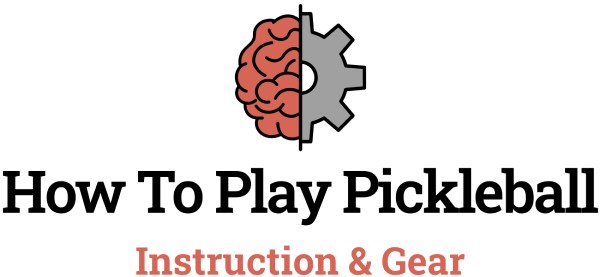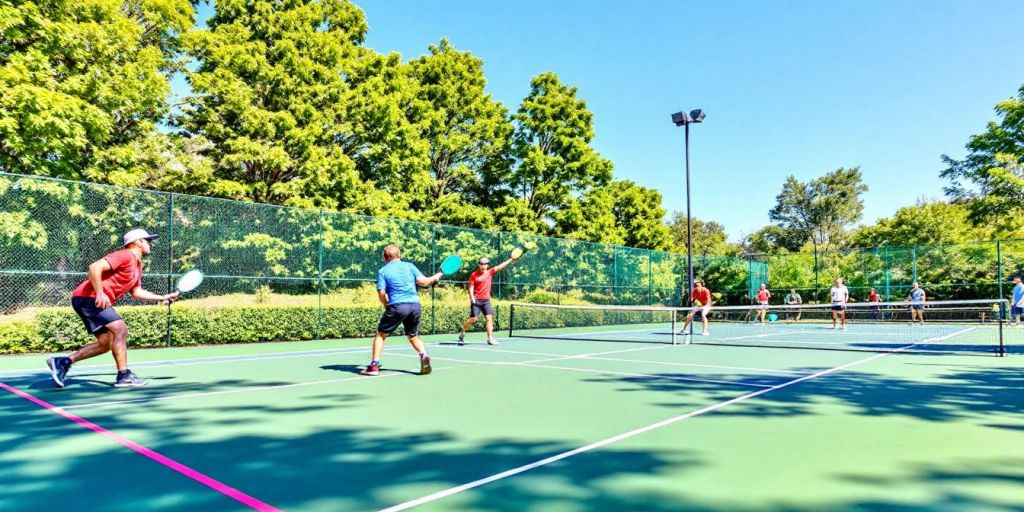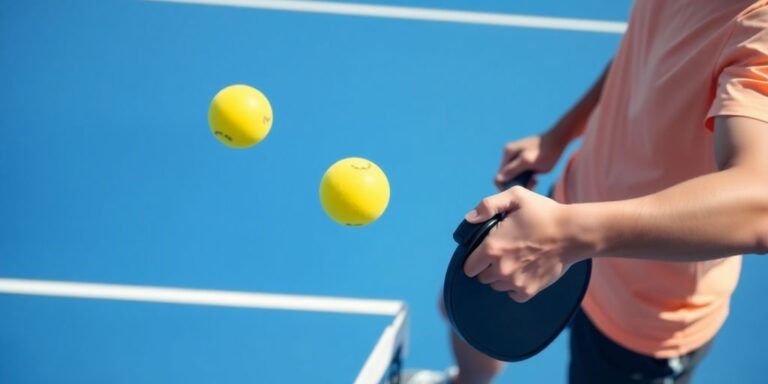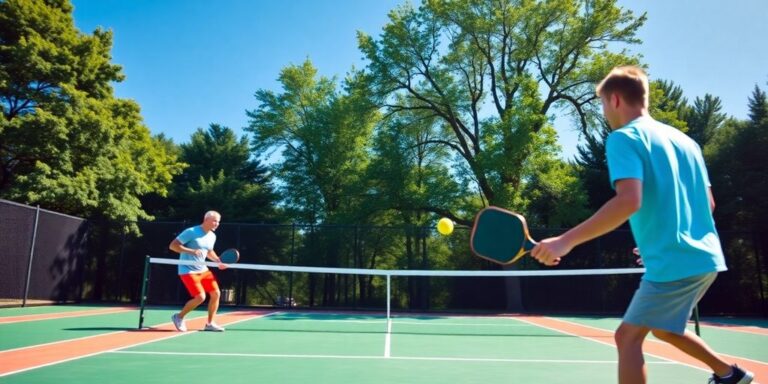Maintaining a pickleball court is vital for ensuring a safe and enjoyable playing experience. Regular upkeep not only extends the life of the court but also enhances its playability. This article will provide essential tips and insights into effective pickleball court maintenance, covering everything from cleaning to professional care.
Key Takeaways
- Understand the materials used in your pickleball court for better maintenance.
- Regularly clean the court to prevent dirt and debris buildup.
- Check for cracks and damage often to avoid bigger repairs later.
- Manage water drainage to protect the court’s surface.
- Choose qualified professionals for maintenance tasks when needed.
Understanding Pickleball Court Composition
Before you can effectively maintain a pickleball court, it’s important to know what it’s made of. Pickleball courts are typically constructed from materials like concrete or asphalt, which are then covered with an acrylic surface. This surface is crucial for providing a good playing experience and ensuring the court lasts a long time.
Materials and Construction
- Concrete: Known for its durability, concrete courts require less frequent maintenance but can crack over time.
- Asphalt: A more affordable option, asphalt courts need regular checks for cracks and may require resurfacing every few years.
- Modular Tiles: These are easy to replace and provide good drainage, but they need regular cleaning to keep them in good shape.
Surface Types and Their Needs
Different surfaces have different maintenance needs:
- Asphalt: Needs crack filling and periodic resurfacing.
- Concrete: Requires cleaning and sealing to prevent moisture damage.
- Modular Tiles: Should be swept regularly and replaced as needed.
Importance of Surface Recognition
Recognizing the type of surface you have is essential for proper maintenance. Each material has its own set of requirements, and understanding these can help you keep the court in top condition.
Maintaining a pickleball court is not just about aesthetics; it’s about ensuring safety and enhancing the playing experience for everyone involved.
Regular Cleaning and Debris Removal

Keeping your pickleball court clean is vital for safety and performance. Regular cleaning helps maintain a safe playing surface and extends the life of the court. Here are some essential practices:
Daily Sweeping Techniques
- Sweep the court every day to remove leaves, dirt, and other debris. This prevents the buildup of materials that could damage the court surface over time. Using a soft broom or a blower is effective for this task.
- Make sure to focus on corners and edges where debris tends to accumulate.
Scheduled Washing Procedures
- At least once a month, wash the court thoroughly. Use a mild detergent mixed with water and apply it with a soft-bristled brush or mop. Rinse well to remove any soap residue, which can affect grip.
- Consider using a pressure washer for deeper cleaning, especially in areas with stubborn stains or mold.
Spot Cleaning for Stains
- For spills or stains, clean them immediately to prevent permanent damage. Use non-abrasive cleaners to avoid harming the surface.
- Regularly check for any signs of mold or mildew, especially in shaded areas.
Benefits of Professional Cleaning
- Hiring professionals for an annual deep clean can be beneficial. They have specialized equipment to remove tough stains without damaging the court.
- Professional cleaning can also help identify any underlying issues that may need attention.
Regular maintenance not only keeps the court safe but also prolongs its lifespan. By investing time in cleaning, you ensure a better playing experience for everyone.
Monitoring for Cracks and Damage
Identifying Surface Cracks
Regular inspections are essential for spotting surface cracks early. Look for:
- Small cracks that can grow larger over time.
- Peeling areas that may indicate underlying issues.
- Damage around net posts where stress is common.
Repairing and Sealing Techniques
For minor cracks, use a high-quality acrylic crack filler. This filler is designed to:
- Expand and contract with temperature changes.
- Prevent cracks from reopening.
- Be compatible with your court’s surface material.
For larger damages, consider professional resurfacing. This process includes:
- Cleaning the surface thoroughly.
- Repairing any significant damage.
- Applying a new layer of acrylic material to restore functionality.
Importance of Timely Maintenance
Timely maintenance is crucial to avoid costly repairs. Ignoring small cracks can lead to bigger problems, affecting both safety and playability. Regular checks can help maintain the court’s integrity and ensure a safe playing environment.
Keeping your court in good shape not only enhances play but also extends its lifespan. Regular maintenance is key to a safe and enjoyable experience for all players.
Managing Moisture and Water Drainage
Effective management of moisture and water drainage is vital for keeping pickleball courts safe and structurally sound. Here are some key strategies to consider:
Ensuring Proper Drainage
- Design with a Slope: Courts should be built with a slight slope to help water flow away, preventing puddles.
- Regular Checks: Inspect drainage systems frequently to ensure they are clear of debris and functioning well.
- Install External Drains: If drainage is poor, consider adding external drains to redirect water away from the court surface.
Sealcoating for Protection
- Apply Every Few Years: A sealcoat should be applied every 2 to 5 years to protect against moisture and UV damage.
- Choose the Right Product: Use sealants specifically made for sports surfaces to ensure they work effectively.
- Maintain Color and Texture: Sealcoating helps keep the court’s color vibrant and maintains the surface texture for better play.
Preventing Water Accumulation
- Regular Cleaning: Keep the court free of debris that can trap water, such as leaves and dirt.
- Monitor for Puddles: After rain, check for standing water and address any drainage issues immediately.
- Professional Assessment: For serious drainage problems, consult professionals to find effective solutions.
Managing moisture effectively not only protects the court but also enhances the playing experience for everyone involved. Regular maintenance is key to longevity.
Ensuring Surface Integrity
Color Coating and Aesthetic Maintenance
Maintaining the color coating of your pickleball court is essential for both appearance and functionality. Regular inspections should be conducted to check for fading or wear. Depending on usage, you may need to reapply the coating every few years to keep the surface looking fresh and performing well.
Surface Leveling and Safety
A flat playing surface is crucial for safety and performance. If you notice any uneven areas, address them quickly. Here are some steps to ensure a level surface:
- Inspect the court regularly for any bumps or dips.
- Use patching compounds designed for sports surfaces to fix minor issues.
- For larger problems, consider resurfacing the entire area to restore its integrity.
Reapplying Non-Slip Coatings
To maintain player safety, it’s important to keep the court’s non-slip surface in good condition. Here’s how to manage this:
- Regularly check the texture of the surface.
- Reapply non-slip coatings as needed, especially after heavy use or weather exposure.
- Ensure that the products used are suitable for sports surfaces to maintain optimal grip.
Keeping your pickleball court in top shape not only enhances the playing experience but also extends its lifespan. Regular maintenance is key to preventing costly repairs and ensuring safety for all players.
Routine Inspection and Maintenance

Inspection Tips for Longevity
Regular inspections are key to keeping your pickleball court in great shape. Here are some tips:
- Check for cracks: Look for any cracks on the surface that could lead to bigger problems.
- Inspect court lines: Ensure that the lines are clear and visible for fair play.
- Examine the net: Make sure the net is secure and not damaged.
Equipment and Net Care
Taking care of your equipment and net is essential for a good playing experience. Here’s what to do:
- Monthly checks: Inspect the net for fraying or loose connections.
- Tighten posts: Ensure that the posts are stable and secure.
- Replace worn parts: If any part of the net or posts is damaged, replace it right away.
Scheduled Maintenance Plans
Creating a maintenance schedule helps keep everything organized. Consider these steps:
- Daily tasks: Sweep the court to remove debris.
- Weekly checks: Inspect for cracks and clean the lines.
- Monthly reviews: Conduct a thorough inspection of the net and surface.
Regular maintenance is crucial for the safety and longevity of your pickleball court. By following these simple steps, you can ensure a safe and enjoyable playing environment for everyone.
Choosing the Right Professionals for Maintenance
When it comes to maintaining your pickleball court, selecting the right team is essential. Here are some key professionals to consider:
Pickleball Court Maintenance Companies
- These companies specialize in court upkeep, offering services like pressure washing, scrubbing, and stain removal.
- They can also handle regular tasks such as sweeping and line painting.
- Look for companies with a good reputation and experience in maintaining pickleball courts.
Landscaping Services for Outdoor Courts
- Landscaping companies can help with outdoor court maintenance, including weed removal and grass trimming.
- They may also provide pressure washing and line painting services.
- Ensure they have experience with pickleball courts to meet your specific needs.
Criteria for Selecting Maintenance Experts
- Experience: Check how long they have been in the business and their expertise in pickleball court maintenance.
- Reputation: Look for reviews or testimonials from previous clients to gauge their reliability.
- Pricing: Compare costs among different professionals to find a service that fits your budget.
Choosing the right professionals can help ensure that your pickleball court remains in top condition, providing a safe and enjoyable playing experience for everyone.
When it comes to keeping your pickleball skills sharp, choosing the right professionals is key. Look for experts who can provide personalized instruction and valuable insights. Don’t miss out on the chance to enhance your game! Visit our website to discover more about our premium courses and exclusive resources that can help you improve your skills today!
Final Thoughts on Pickleball Court Care
Taking care of your pickleball court is very important for keeping it safe and fun to play on. By regularly cleaning and checking for damage, you can make sure the court lasts a long time and stays in great shape. Remember, a well-kept court not only looks nice but also helps players enjoy the game more. So, don’t wait! Start your maintenance routine today to keep your pickleball court ready for action for many years to come.
Frequently Asked Questions
What materials are used to build pickleball courts?
Pickleball courts are usually made from concrete or asphalt, topped with an acrylic surface for better play and durability.
How often should I clean my pickleball court?
It’s best to sweep the court daily and wash it at least once a month to keep it clean and safe for players.
What should I do if I find cracks on my court?
If you see cracks, it’s important to repair them right away to prevent further damage and ensure player safety.
How can I manage water on my pickleball court?
Make sure the court has good drainage to prevent water from pooling, and consider sealcoating every few years for added protection.
Why is regular maintenance important for a pickleball court?
Regular maintenance helps extend the life of the court, keeps it safe for players, and can save money on costly repairs later.
When should I hire professionals for maintenance?
For major repairs or deep cleaning, it’s a good idea to hire professionals who have the right tools and expertise.




